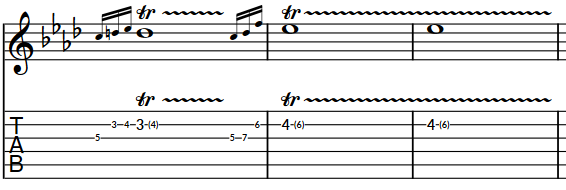Trills
Trills are fast alternations between two notes, similar to a tremolo, that were a common decoration in Baroque, Classical, and Romantic music. Trill marks are usually added to a single note, to indicate the performed notes are the notated pitch and the note either a half-step or whole step above, and can have extension lines to show the duration of the trill.

Because of their legacy as an ornament, many performers interpret trills differently to tremolos: some players add more emphasis to the notated pitch in a trill and less on the trilled-to note but play both notes equally in tremolos.
The most common trills are to notes a major or minor second above, but it is also possible to specify other trill intervals.
In Dorico Pro, you can specify any trill interval, change their appearance on notation staves, and hear them in playback.
On tablature, the trilled-to pitch always appears as a parenthesized fret number.
